Assessing Socioeconomic Impact of RVF on Maasai Pastoralists, Kenya
VerifiedAdded on 2022/11/04
|11
|2859
|359
Project
AI Summary
This project presents a comprehensive study on the socioeconomic impact of Rift Valley Fever (RVF) on Maasai pastoralists in Laikipia County, Kenya. The research, conducted over 24 months, aims to understand the disease's effects on the pastoralists' livelihoods, health, and economic activities. The study employs a two-stage probability sampling method to select participants from three sub-counties, focusing on Maasai pastoralists and utilizing both qualitative and quantitative data collection methods, including interviews and thematic analysis. The findings are expected to inform the Ministry of Health and other stakeholders, providing insights to improve healthcare services and create awareness about RVF. The study's rationale highlights the significance of RVF as a major zoonotic disease impacting both humans and livestock, particularly in regions with favorable mosquito breeding climates. Ethical considerations are addressed through ethical approval and informed consent. The study's limitations include its focus on three sub-counties and potential participant reluctance. The project anticipates a significant socioeconomic impact, emphasizing the need for intervention strategies and awareness creation to mitigate the disease's effects.
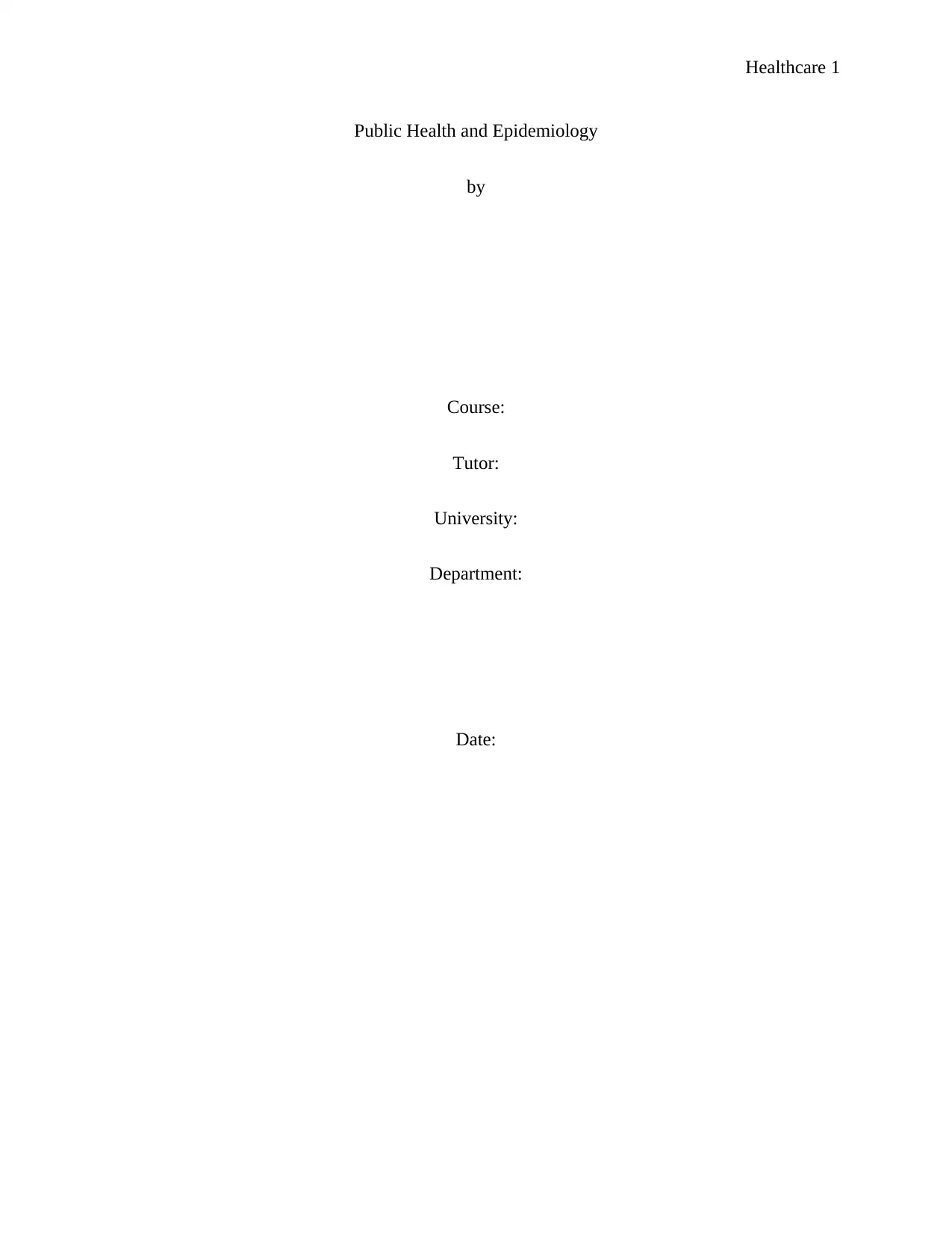
Healthcare 1
Public Health and Epidemiology
by
Course:
Tutor:
University:
Department:
Date:
Public Health and Epidemiology
by
Course:
Tutor:
University:
Department:
Date:
Paraphrase This Document
Need a fresh take? Get an instant paraphrase of this document with our AI Paraphraser
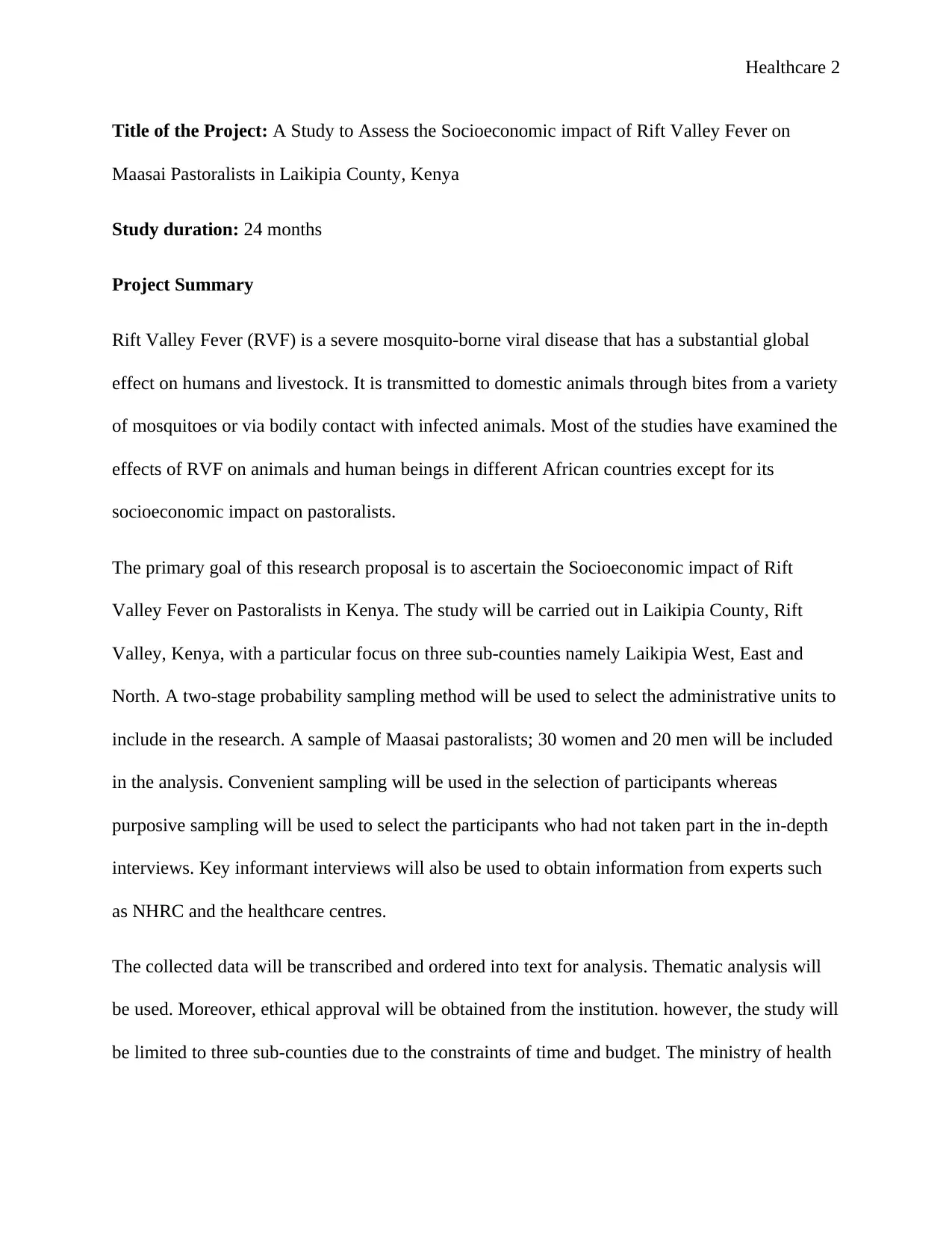
Healthcare 2
Title of the Project: A Study to Assess the Socioeconomic impact of Rift Valley Fever on
Maasai Pastoralists in Laikipia County, Kenya
Study duration: 24 months
Project Summary
Rift Valley Fever (RVF) is a severe mosquito-borne viral disease that has a substantial global
effect on humans and livestock. It is transmitted to domestic animals through bites from a variety
of mosquitoes or via bodily contact with infected animals. Most of the studies have examined the
effects of RVF on animals and human beings in different African countries except for its
socioeconomic impact on pastoralists.
The primary goal of this research proposal is to ascertain the Socioeconomic impact of Rift
Valley Fever on Pastoralists in Kenya. The study will be carried out in Laikipia County, Rift
Valley, Kenya, with a particular focus on three sub-counties namely Laikipia West, East and
North. A two-stage probability sampling method will be used to select the administrative units to
include in the research. A sample of Maasai pastoralists; 30 women and 20 men will be included
in the analysis. Convenient sampling will be used in the selection of participants whereas
purposive sampling will be used to select the participants who had not taken part in the in-depth
interviews. Key informant interviews will also be used to obtain information from experts such
as NHRC and the healthcare centres.
The collected data will be transcribed and ordered into text for analysis. Thematic analysis will
be used. Moreover, ethical approval will be obtained from the institution. however, the study will
be limited to three sub-counties due to the constraints of time and budget. The ministry of health
Title of the Project: A Study to Assess the Socioeconomic impact of Rift Valley Fever on
Maasai Pastoralists in Laikipia County, Kenya
Study duration: 24 months
Project Summary
Rift Valley Fever (RVF) is a severe mosquito-borne viral disease that has a substantial global
effect on humans and livestock. It is transmitted to domestic animals through bites from a variety
of mosquitoes or via bodily contact with infected animals. Most of the studies have examined the
effects of RVF on animals and human beings in different African countries except for its
socioeconomic impact on pastoralists.
The primary goal of this research proposal is to ascertain the Socioeconomic impact of Rift
Valley Fever on Pastoralists in Kenya. The study will be carried out in Laikipia County, Rift
Valley, Kenya, with a particular focus on three sub-counties namely Laikipia West, East and
North. A two-stage probability sampling method will be used to select the administrative units to
include in the research. A sample of Maasai pastoralists; 30 women and 20 men will be included
in the analysis. Convenient sampling will be used in the selection of participants whereas
purposive sampling will be used to select the participants who had not taken part in the in-depth
interviews. Key informant interviews will also be used to obtain information from experts such
as NHRC and the healthcare centres.
The collected data will be transcribed and ordered into text for analysis. Thematic analysis will
be used. Moreover, ethical approval will be obtained from the institution. however, the study will
be limited to three sub-counties due to the constraints of time and budget. The ministry of health

Healthcare 3
and other stakeholders can use the outcomes of the study to improve their healthcare services to
pastoralists and create awareness on the existing prevalence of RVF.
Rationale and Background
Rift Valley Fever (RVF) is a severe mosquito-borne viral disease that has a substantial global
effect on humans and livestock. The disease is usually characterized by high death rate (all
newborn animals and 20% of adult animals) in ruminant livestock such as cattle and sheep and
increased incidences of abortion rates especially in infected pregnant animals (1). Rift Valley
Fever is the major cause of the most common zoonotic outbreak in developing countries.
According to the World Health Organization (2), there are 10,000 per year confirmed cases of
RVF in humans. RVFV is transmitted to domestic animals through bites from a variety of
mosquitoes or via bodily contact with infected animals (2). Human transmission of the virus
occurs by arthropod vectors or through any other direct contact with infected animals (3). The
prevalence of the disease in Kenya has been associated with its favourable climate for the
breeding of mosquitoes. For instance, the study by (4) showed the existence of a positive
relationship between RVF outbreaks and high incidence of mosquitoes, high rainfall and the
existence of large water bodies such as ponds and lakes. The disease results in abortions in
pregnant animals and almost 100% mortality rate of prenatal (5). The symptoms of the disease in
humans include strong headaches, nausea, high fever, dizziness, body pain among others (6).
Livestock production is a significant industry in Kenya, and it is the second-largest contributor to
the overal agricultural GDP. Although livestock production is an important determinant of the
Kenyan economy, it remains susceptible to RVF. The herdsmen and farmworkers are the most
affected because they live close to their animals and do directly handle the animals and their
and other stakeholders can use the outcomes of the study to improve their healthcare services to
pastoralists and create awareness on the existing prevalence of RVF.
Rationale and Background
Rift Valley Fever (RVF) is a severe mosquito-borne viral disease that has a substantial global
effect on humans and livestock. The disease is usually characterized by high death rate (all
newborn animals and 20% of adult animals) in ruminant livestock such as cattle and sheep and
increased incidences of abortion rates especially in infected pregnant animals (1). Rift Valley
Fever is the major cause of the most common zoonotic outbreak in developing countries.
According to the World Health Organization (2), there are 10,000 per year confirmed cases of
RVF in humans. RVFV is transmitted to domestic animals through bites from a variety of
mosquitoes or via bodily contact with infected animals (2). Human transmission of the virus
occurs by arthropod vectors or through any other direct contact with infected animals (3). The
prevalence of the disease in Kenya has been associated with its favourable climate for the
breeding of mosquitoes. For instance, the study by (4) showed the existence of a positive
relationship between RVF outbreaks and high incidence of mosquitoes, high rainfall and the
existence of large water bodies such as ponds and lakes. The disease results in abortions in
pregnant animals and almost 100% mortality rate of prenatal (5). The symptoms of the disease in
humans include strong headaches, nausea, high fever, dizziness, body pain among others (6).
Livestock production is a significant industry in Kenya, and it is the second-largest contributor to
the overal agricultural GDP. Although livestock production is an important determinant of the
Kenyan economy, it remains susceptible to RVF. The herdsmen and farmworkers are the most
affected because they live close to their animals and do directly handle the animals and their
⊘ This is a preview!⊘
Do you want full access?
Subscribe today to unlock all pages.

Trusted by 1+ million students worldwide
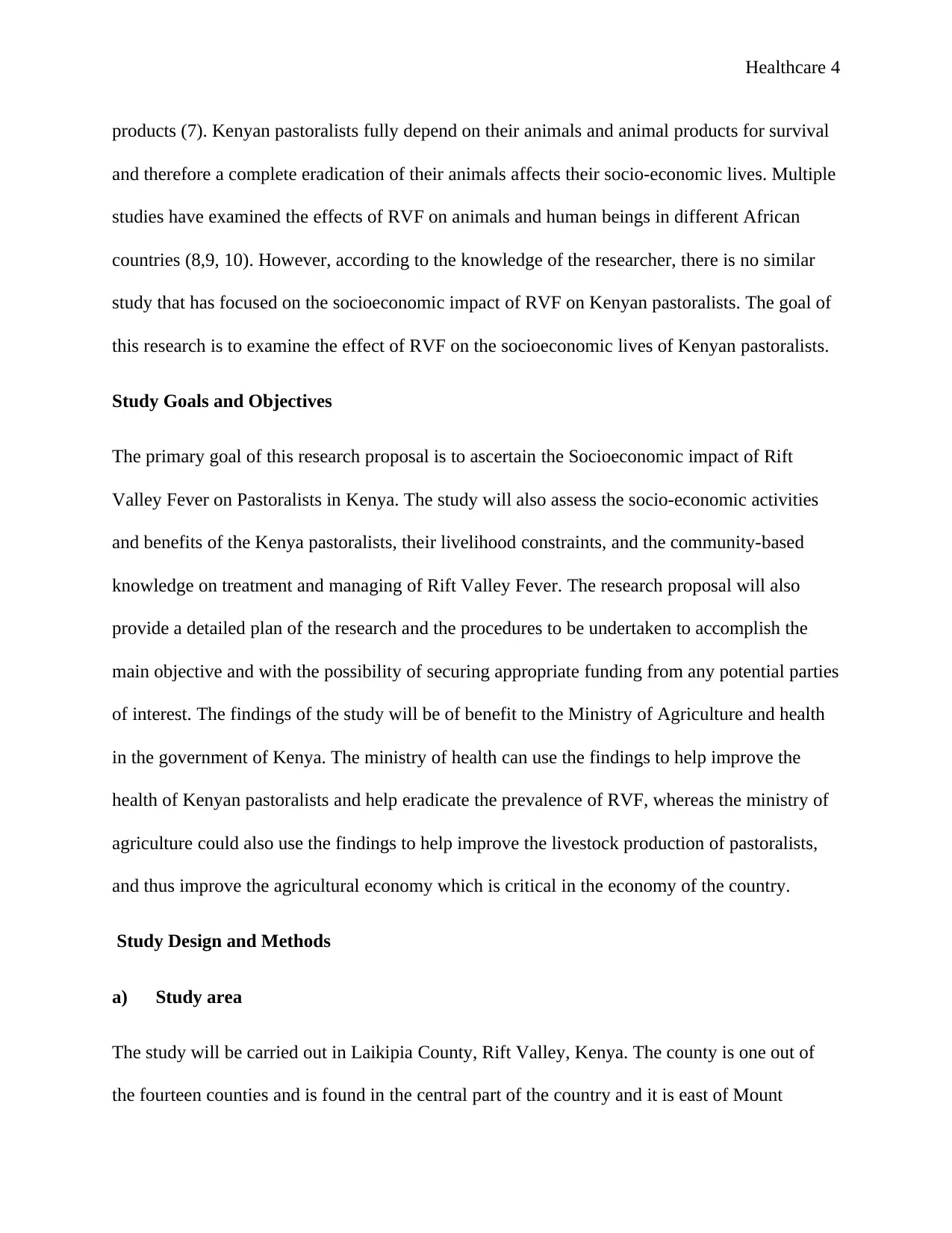
Healthcare 4
products (7). Kenyan pastoralists fully depend on their animals and animal products for survival
and therefore a complete eradication of their animals affects their socio-economic lives. Multiple
studies have examined the effects of RVF on animals and human beings in different African
countries (8,9, 10). However, according to the knowledge of the researcher, there is no similar
study that has focused on the socioeconomic impact of RVF on Kenyan pastoralists. The goal of
this research is to examine the effect of RVF on the socioeconomic lives of Kenyan pastoralists.
Study Goals and Objectives
The primary goal of this research proposal is to ascertain the Socioeconomic impact of Rift
Valley Fever on Pastoralists in Kenya. The study will also assess the socio-economic activities
and benefits of the Kenya pastoralists, their livelihood constraints, and the community-based
knowledge on treatment and managing of Rift Valley Fever. The research proposal will also
provide a detailed plan of the research and the procedures to be undertaken to accomplish the
main objective and with the possibility of securing appropriate funding from any potential parties
of interest. The findings of the study will be of benefit to the Ministry of Agriculture and health
in the government of Kenya. The ministry of health can use the findings to help improve the
health of Kenyan pastoralists and help eradicate the prevalence of RVF, whereas the ministry of
agriculture could also use the findings to help improve the livestock production of pastoralists,
and thus improve the agricultural economy which is critical in the economy of the country.
Study Design and Methods
a) Study area
The study will be carried out in Laikipia County, Rift Valley, Kenya. The county is one out of
the fourteen counties and is found in the central part of the country and it is east of Mount
products (7). Kenyan pastoralists fully depend on their animals and animal products for survival
and therefore a complete eradication of their animals affects their socio-economic lives. Multiple
studies have examined the effects of RVF on animals and human beings in different African
countries (8,9, 10). However, according to the knowledge of the researcher, there is no similar
study that has focused on the socioeconomic impact of RVF on Kenyan pastoralists. The goal of
this research is to examine the effect of RVF on the socioeconomic lives of Kenyan pastoralists.
Study Goals and Objectives
The primary goal of this research proposal is to ascertain the Socioeconomic impact of Rift
Valley Fever on Pastoralists in Kenya. The study will also assess the socio-economic activities
and benefits of the Kenya pastoralists, their livelihood constraints, and the community-based
knowledge on treatment and managing of Rift Valley Fever. The research proposal will also
provide a detailed plan of the research and the procedures to be undertaken to accomplish the
main objective and with the possibility of securing appropriate funding from any potential parties
of interest. The findings of the study will be of benefit to the Ministry of Agriculture and health
in the government of Kenya. The ministry of health can use the findings to help improve the
health of Kenyan pastoralists and help eradicate the prevalence of RVF, whereas the ministry of
agriculture could also use the findings to help improve the livestock production of pastoralists,
and thus improve the agricultural economy which is critical in the economy of the country.
Study Design and Methods
a) Study area
The study will be carried out in Laikipia County, Rift Valley, Kenya. The county is one out of
the fourteen counties and is found in the central part of the country and it is east of Mount
Paraphrase This Document
Need a fresh take? Get an instant paraphrase of this document with our AI Paraphraser
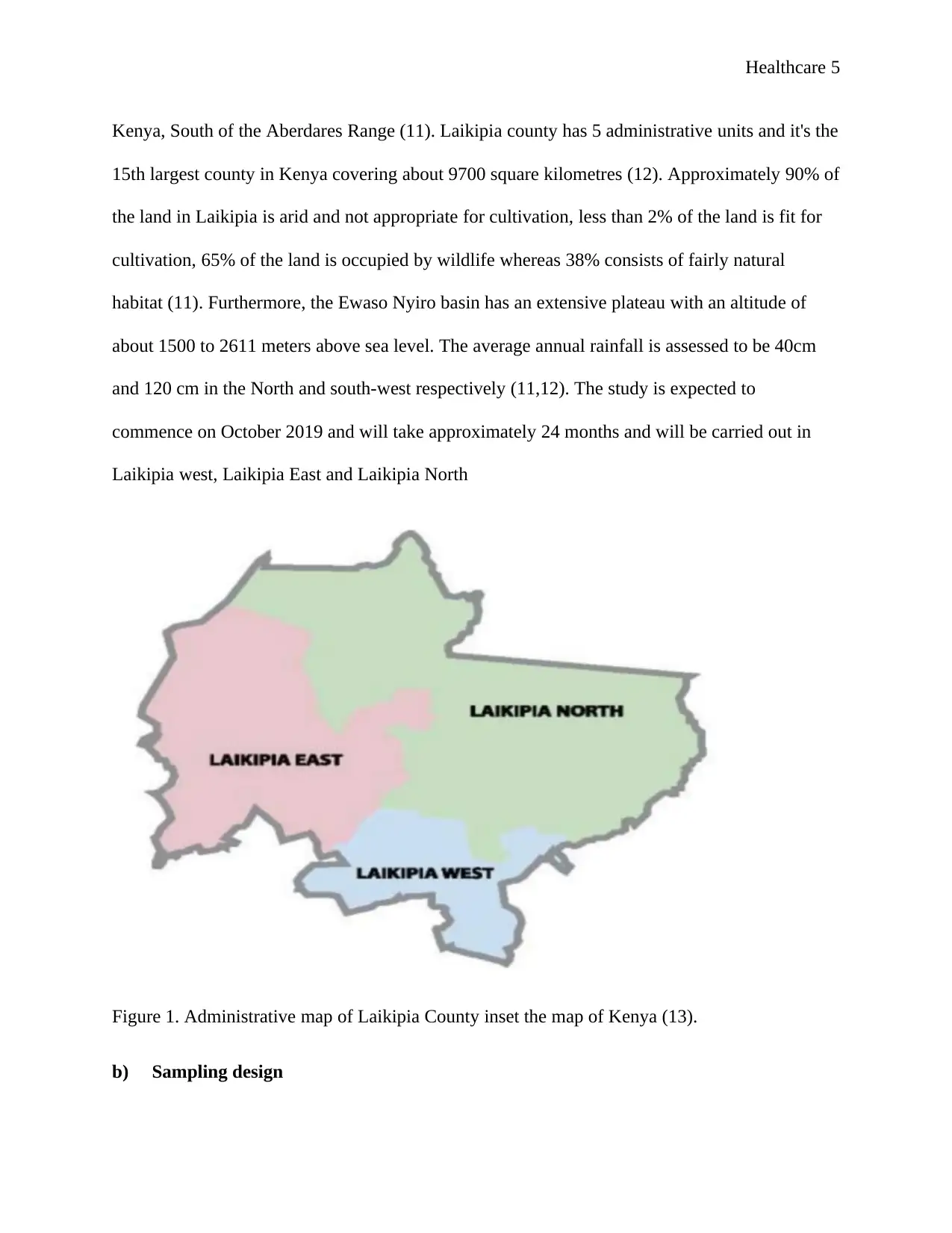
Healthcare 5
Kenya, South of the Aberdares Range (11). Laikipia county has 5 administrative units and it's the
15th largest county in Kenya covering about 9700 square kilometres (12). Approximately 90% of
the land in Laikipia is arid and not appropriate for cultivation, less than 2% of the land is fit for
cultivation, 65% of the land is occupied by wildlife whereas 38% consists of fairly natural
habitat (11). Furthermore, the Ewaso Nyiro basin has an extensive plateau with an altitude of
about 1500 to 2611 meters above sea level. The average annual rainfall is assessed to be 40cm
and 120 cm in the North and south-west respectively (11,12). The study is expected to
commence on October 2019 and will take approximately 24 months and will be carried out in
Laikipia west, Laikipia East and Laikipia North
Figure 1. Administrative map of Laikipia County inset the map of Kenya (13).
b) Sampling design
Kenya, South of the Aberdares Range (11). Laikipia county has 5 administrative units and it's the
15th largest county in Kenya covering about 9700 square kilometres (12). Approximately 90% of
the land in Laikipia is arid and not appropriate for cultivation, less than 2% of the land is fit for
cultivation, 65% of the land is occupied by wildlife whereas 38% consists of fairly natural
habitat (11). Furthermore, the Ewaso Nyiro basin has an extensive plateau with an altitude of
about 1500 to 2611 meters above sea level. The average annual rainfall is assessed to be 40cm
and 120 cm in the North and south-west respectively (11,12). The study is expected to
commence on October 2019 and will take approximately 24 months and will be carried out in
Laikipia west, Laikipia East and Laikipia North
Figure 1. Administrative map of Laikipia County inset the map of Kenya (13).
b) Sampling design

Healthcare 6
Sampling is a process of selecting units from a population of interest so that by examining the
sample the outcomes can be wholly be applied to the population from which they were selected.
The study will use two-stage probability sampling namely primary and secondary sampling (14).
Primary sampling will consist of the selection of three administrative units from the existing five
units. Based on the availability of resources such as time and personnel, three sub-counties will
be selected for the study, these include Laikipia west, Laikipia East and Laikipia North.
Secondary sampling will also be carried out in consultation with the animal health experts of the
selected sub-counties to select the most affected areas in each unit for assessment.
c) Sample size consideration
The study population will comprise of the Maasai pastoralists and the Maasai community will be
used as the unit of analysis because it is the one actively involved in pastoral activities. The
sample is expected to be made up of 30 women and 20 men. The variation in gender is likely to
be attributed to the fact that most women will be found at the homesteads as opposed to men who
are engaged in pastoralism. The researcher will gather qualitative data and the participants
selected using convenient sampling. Secondary data will be gathered from relevant existing
literature on the Maasai pastoralists in Laikipia county, their roles and nomadic characteristics.
In-depth interviews will be used to collect data from the pastoralists at the household level. Key
informant interviews will also be used to obtain information experts in the healthcare sector and
the ministry of health. Purposive sampling will be used to select the discussants from the
community households who had not taken part in the in-depth interviews. A sample size of 50
pastoralists will be appropriate for the three sub-counties because it is sparsely populated and is
all pastoralists who are affected by relatively similar problems.
Sampling is a process of selecting units from a population of interest so that by examining the
sample the outcomes can be wholly be applied to the population from which they were selected.
The study will use two-stage probability sampling namely primary and secondary sampling (14).
Primary sampling will consist of the selection of three administrative units from the existing five
units. Based on the availability of resources such as time and personnel, three sub-counties will
be selected for the study, these include Laikipia west, Laikipia East and Laikipia North.
Secondary sampling will also be carried out in consultation with the animal health experts of the
selected sub-counties to select the most affected areas in each unit for assessment.
c) Sample size consideration
The study population will comprise of the Maasai pastoralists and the Maasai community will be
used as the unit of analysis because it is the one actively involved in pastoral activities. The
sample is expected to be made up of 30 women and 20 men. The variation in gender is likely to
be attributed to the fact that most women will be found at the homesteads as opposed to men who
are engaged in pastoralism. The researcher will gather qualitative data and the participants
selected using convenient sampling. Secondary data will be gathered from relevant existing
literature on the Maasai pastoralists in Laikipia county, their roles and nomadic characteristics.
In-depth interviews will be used to collect data from the pastoralists at the household level. Key
informant interviews will also be used to obtain information experts in the healthcare sector and
the ministry of health. Purposive sampling will be used to select the discussants from the
community households who had not taken part in the in-depth interviews. A sample size of 50
pastoralists will be appropriate for the three sub-counties because it is sparsely populated and is
all pastoralists who are affected by relatively similar problems.
⊘ This is a preview!⊘
Do you want full access?
Subscribe today to unlock all pages.

Trusted by 1+ million students worldwide
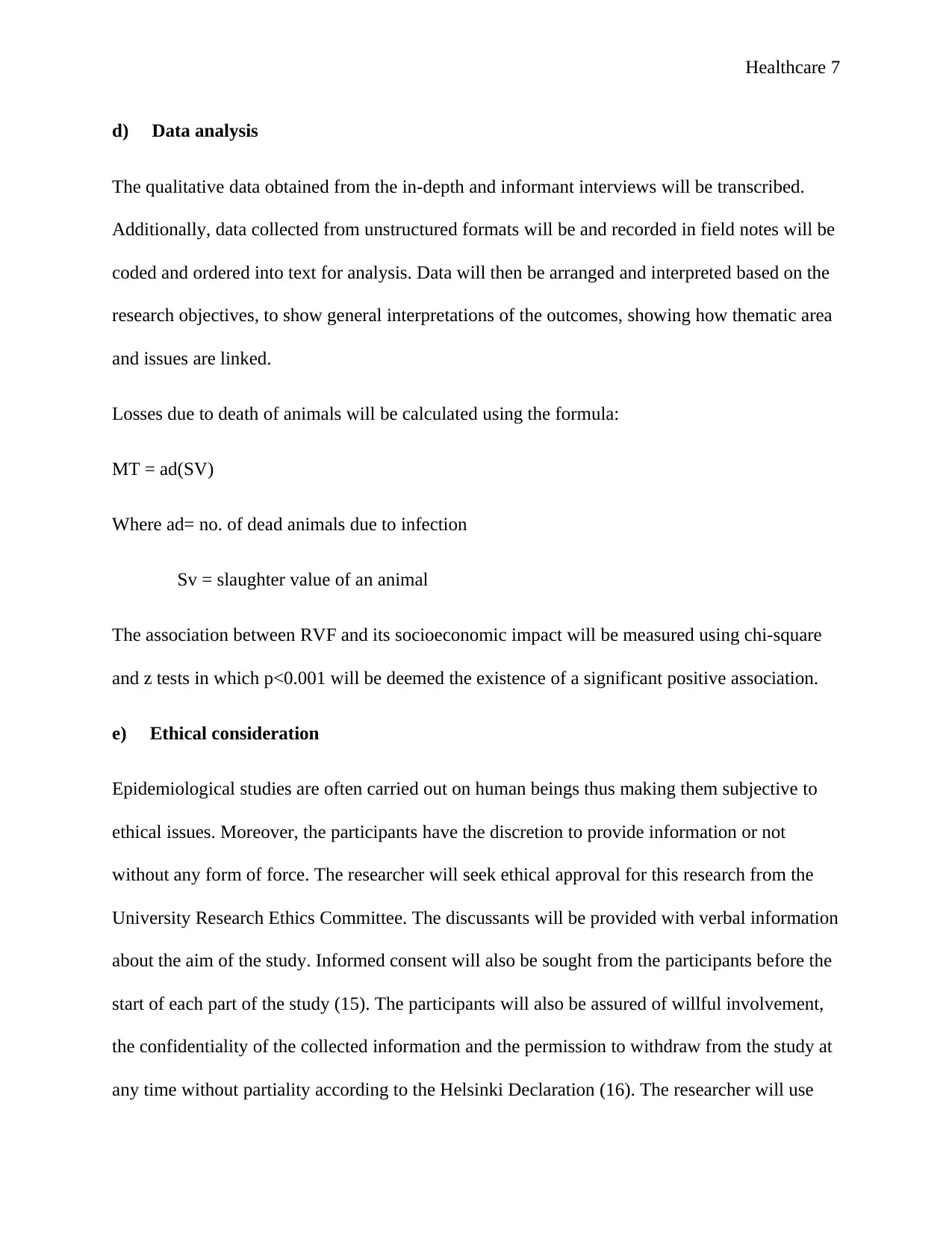
Healthcare 7
d) Data analysis
The qualitative data obtained from the in-depth and informant interviews will be transcribed.
Additionally, data collected from unstructured formats will be and recorded in field notes will be
coded and ordered into text for analysis. Data will then be arranged and interpreted based on the
research objectives, to show general interpretations of the outcomes, showing how thematic area
and issues are linked.
Losses due to death of animals will be calculated using the formula:
MT = ad(SV)
Where ad= no. of dead animals due to infection
Sv = slaughter value of an animal
The association between RVF and its socioeconomic impact will be measured using chi-square
and z tests in which p<0.001 will be deemed the existence of a significant positive association.
e) Ethical consideration
Epidemiological studies are often carried out on human beings thus making them subjective to
ethical issues. Moreover, the participants have the discretion to provide information or not
without any form of force. The researcher will seek ethical approval for this research from the
University Research Ethics Committee. The discussants will be provided with verbal information
about the aim of the study. Informed consent will also be sought from the participants before the
start of each part of the study (15). The participants will also be assured of willful involvement,
the confidentiality of the collected information and the permission to withdraw from the study at
any time without partiality according to the Helsinki Declaration (16). The researcher will use
d) Data analysis
The qualitative data obtained from the in-depth and informant interviews will be transcribed.
Additionally, data collected from unstructured formats will be and recorded in field notes will be
coded and ordered into text for analysis. Data will then be arranged and interpreted based on the
research objectives, to show general interpretations of the outcomes, showing how thematic area
and issues are linked.
Losses due to death of animals will be calculated using the formula:
MT = ad(SV)
Where ad= no. of dead animals due to infection
Sv = slaughter value of an animal
The association between RVF and its socioeconomic impact will be measured using chi-square
and z tests in which p<0.001 will be deemed the existence of a significant positive association.
e) Ethical consideration
Epidemiological studies are often carried out on human beings thus making them subjective to
ethical issues. Moreover, the participants have the discretion to provide information or not
without any form of force. The researcher will seek ethical approval for this research from the
University Research Ethics Committee. The discussants will be provided with verbal information
about the aim of the study. Informed consent will also be sought from the participants before the
start of each part of the study (15). The participants will also be assured of willful involvement,
the confidentiality of the collected information and the permission to withdraw from the study at
any time without partiality according to the Helsinki Declaration (16). The researcher will use
Paraphrase This Document
Need a fresh take? Get an instant paraphrase of this document with our AI Paraphraser
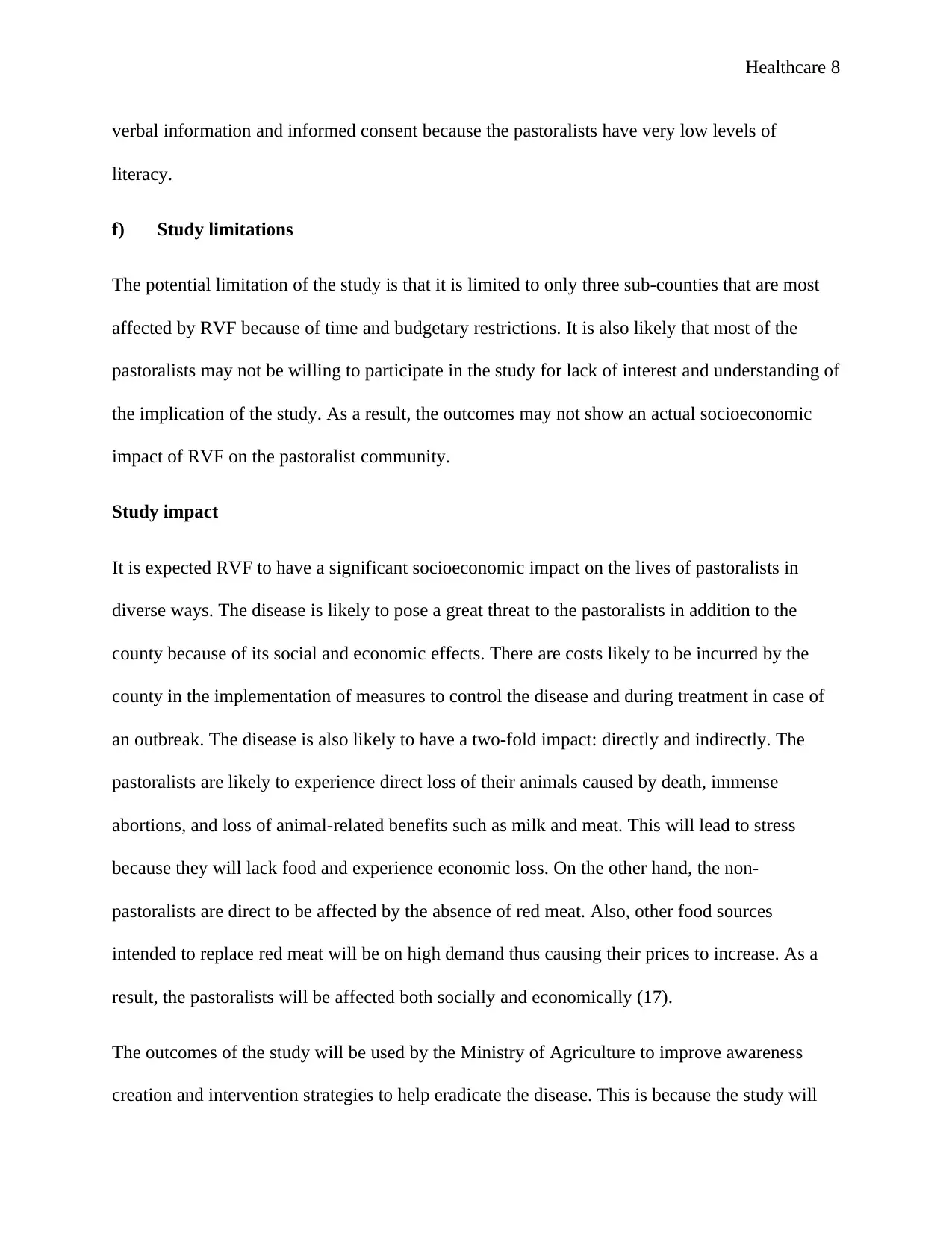
Healthcare 8
verbal information and informed consent because the pastoralists have very low levels of
literacy.
f) Study limitations
The potential limitation of the study is that it is limited to only three sub-counties that are most
affected by RVF because of time and budgetary restrictions. It is also likely that most of the
pastoralists may not be willing to participate in the study for lack of interest and understanding of
the implication of the study. As a result, the outcomes may not show an actual socioeconomic
impact of RVF on the pastoralist community.
Study impact
It is expected RVF to have a significant socioeconomic impact on the lives of pastoralists in
diverse ways. The disease is likely to pose a great threat to the pastoralists in addition to the
county because of its social and economic effects. There are costs likely to be incurred by the
county in the implementation of measures to control the disease and during treatment in case of
an outbreak. The disease is also likely to have a two-fold impact: directly and indirectly. The
pastoralists are likely to experience direct loss of their animals caused by death, immense
abortions, and loss of animal-related benefits such as milk and meat. This will lead to stress
because they will lack food and experience economic loss. On the other hand, the non-
pastoralists are direct to be affected by the absence of red meat. Also, other food sources
intended to replace red meat will be on high demand thus causing their prices to increase. As a
result, the pastoralists will be affected both socially and economically (17).
The outcomes of the study will be used by the Ministry of Agriculture to improve awareness
creation and intervention strategies to help eradicate the disease. This is because the study will
verbal information and informed consent because the pastoralists have very low levels of
literacy.
f) Study limitations
The potential limitation of the study is that it is limited to only three sub-counties that are most
affected by RVF because of time and budgetary restrictions. It is also likely that most of the
pastoralists may not be willing to participate in the study for lack of interest and understanding of
the implication of the study. As a result, the outcomes may not show an actual socioeconomic
impact of RVF on the pastoralist community.
Study impact
It is expected RVF to have a significant socioeconomic impact on the lives of pastoralists in
diverse ways. The disease is likely to pose a great threat to the pastoralists in addition to the
county because of its social and economic effects. There are costs likely to be incurred by the
county in the implementation of measures to control the disease and during treatment in case of
an outbreak. The disease is also likely to have a two-fold impact: directly and indirectly. The
pastoralists are likely to experience direct loss of their animals caused by death, immense
abortions, and loss of animal-related benefits such as milk and meat. This will lead to stress
because they will lack food and experience economic loss. On the other hand, the non-
pastoralists are direct to be affected by the absence of red meat. Also, other food sources
intended to replace red meat will be on high demand thus causing their prices to increase. As a
result, the pastoralists will be affected both socially and economically (17).
The outcomes of the study will be used by the Ministry of Agriculture to improve awareness
creation and intervention strategies to help eradicate the disease. This is because the study will
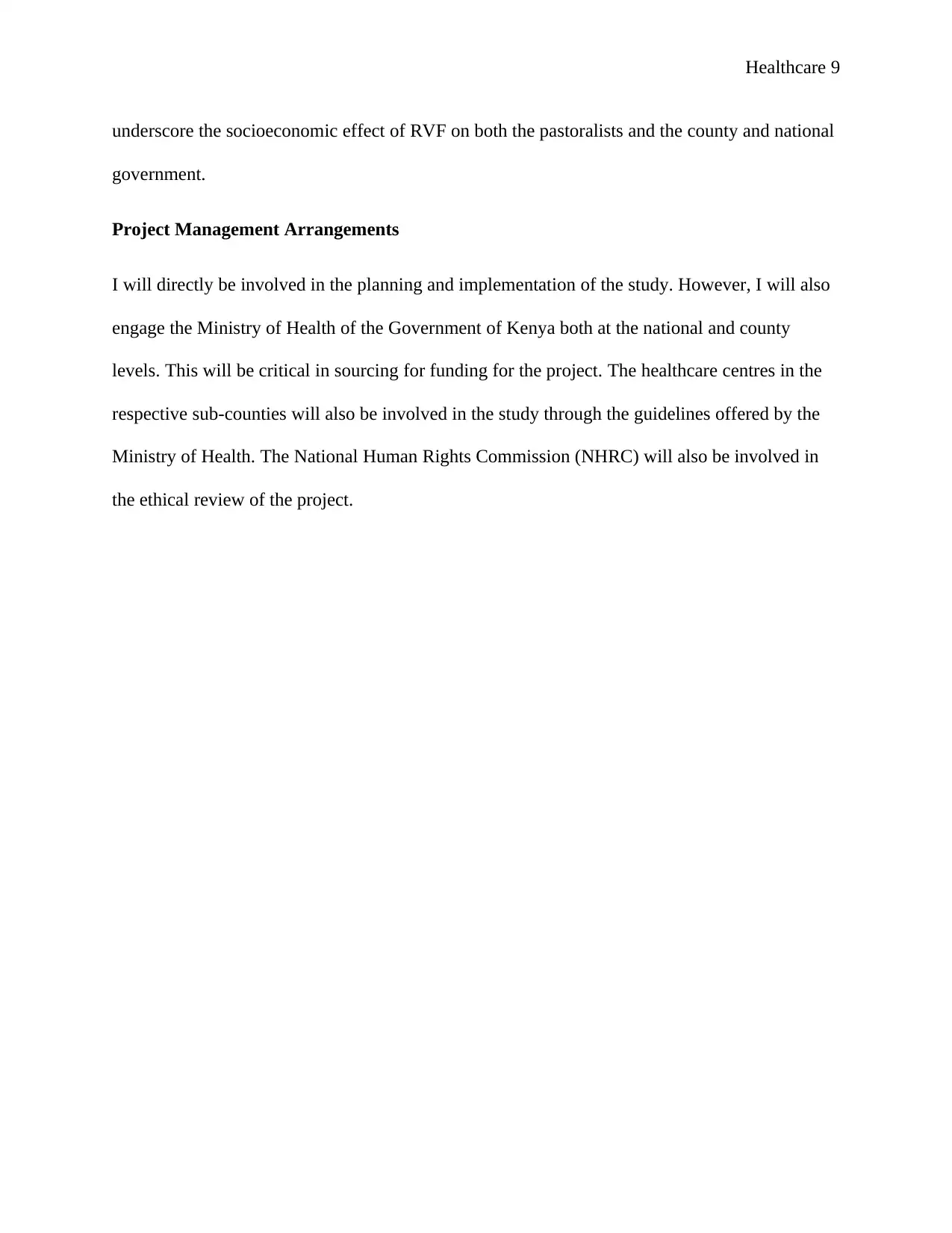
Healthcare 9
underscore the socioeconomic effect of RVF on both the pastoralists and the county and national
government.
Project Management Arrangements
I will directly be involved in the planning and implementation of the study. However, I will also
engage the Ministry of Health of the Government of Kenya both at the national and county
levels. This will be critical in sourcing for funding for the project. The healthcare centres in the
respective sub-counties will also be involved in the study through the guidelines offered by the
Ministry of Health. The National Human Rights Commission (NHRC) will also be involved in
the ethical review of the project.
underscore the socioeconomic effect of RVF on both the pastoralists and the county and national
government.
Project Management Arrangements
I will directly be involved in the planning and implementation of the study. However, I will also
engage the Ministry of Health of the Government of Kenya both at the national and county
levels. This will be critical in sourcing for funding for the project. The healthcare centres in the
respective sub-counties will also be involved in the study through the guidelines offered by the
Ministry of Health. The National Human Rights Commission (NHRC) will also be involved in
the ethical review of the project.
⊘ This is a preview!⊘
Do you want full access?
Subscribe today to unlock all pages.

Trusted by 1+ million students worldwide
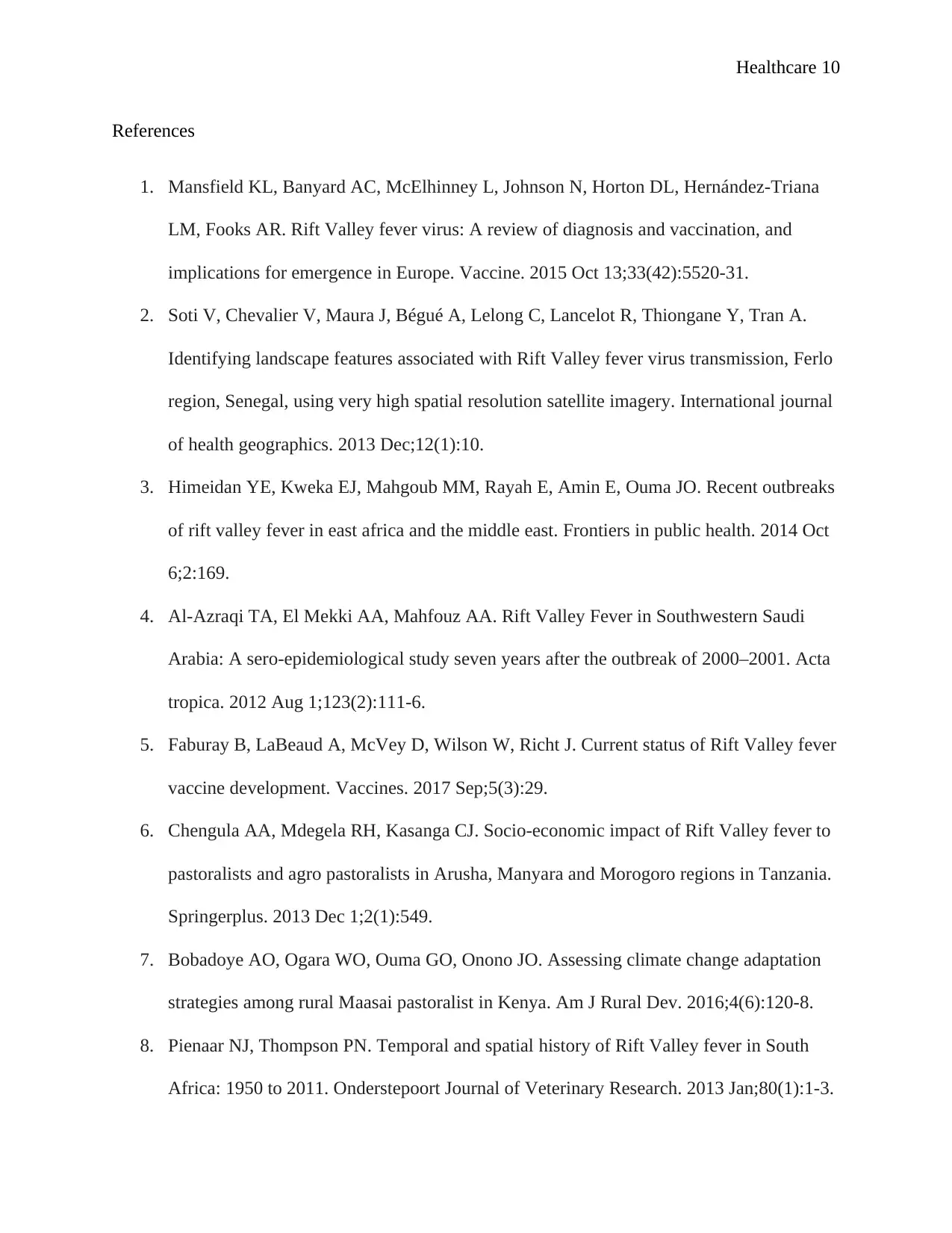
Healthcare 10
References
1. Mansfield KL, Banyard AC, McElhinney L, Johnson N, Horton DL, Hernández-Triana
LM, Fooks AR. Rift Valley fever virus: A review of diagnosis and vaccination, and
implications for emergence in Europe. Vaccine. 2015 Oct 13;33(42):5520-31.
2. Soti V, Chevalier V, Maura J, Bégué A, Lelong C, Lancelot R, Thiongane Y, Tran A.
Identifying landscape features associated with Rift Valley fever virus transmission, Ferlo
region, Senegal, using very high spatial resolution satellite imagery. International journal
of health geographics. 2013 Dec;12(1):10.
3. Himeidan YE, Kweka EJ, Mahgoub MM, Rayah E, Amin E, Ouma JO. Recent outbreaks
of rift valley fever in east africa and the middle east. Frontiers in public health. 2014 Oct
6;2:169.
4. Al-Azraqi TA, El Mekki AA, Mahfouz AA. Rift Valley Fever in Southwestern Saudi
Arabia: A sero-epidemiological study seven years after the outbreak of 2000–2001. Acta
tropica. 2012 Aug 1;123(2):111-6.
5. Faburay B, LaBeaud A, McVey D, Wilson W, Richt J. Current status of Rift Valley fever
vaccine development. Vaccines. 2017 Sep;5(3):29.
6. Chengula AA, Mdegela RH, Kasanga CJ. Socio-economic impact of Rift Valley fever to
pastoralists and agro pastoralists in Arusha, Manyara and Morogoro regions in Tanzania.
Springerplus. 2013 Dec 1;2(1):549.
7. Bobadoye AO, Ogara WO, Ouma GO, Onono JO. Assessing climate change adaptation
strategies among rural Maasai pastoralist in Kenya. Am J Rural Dev. 2016;4(6):120-8.
8. Pienaar NJ, Thompson PN. Temporal and spatial history of Rift Valley fever in South
Africa: 1950 to 2011. Onderstepoort Journal of Veterinary Research. 2013 Jan;80(1):1-3.
References
1. Mansfield KL, Banyard AC, McElhinney L, Johnson N, Horton DL, Hernández-Triana
LM, Fooks AR. Rift Valley fever virus: A review of diagnosis and vaccination, and
implications for emergence in Europe. Vaccine. 2015 Oct 13;33(42):5520-31.
2. Soti V, Chevalier V, Maura J, Bégué A, Lelong C, Lancelot R, Thiongane Y, Tran A.
Identifying landscape features associated with Rift Valley fever virus transmission, Ferlo
region, Senegal, using very high spatial resolution satellite imagery. International journal
of health geographics. 2013 Dec;12(1):10.
3. Himeidan YE, Kweka EJ, Mahgoub MM, Rayah E, Amin E, Ouma JO. Recent outbreaks
of rift valley fever in east africa and the middle east. Frontiers in public health. 2014 Oct
6;2:169.
4. Al-Azraqi TA, El Mekki AA, Mahfouz AA. Rift Valley Fever in Southwestern Saudi
Arabia: A sero-epidemiological study seven years after the outbreak of 2000–2001. Acta
tropica. 2012 Aug 1;123(2):111-6.
5. Faburay B, LaBeaud A, McVey D, Wilson W, Richt J. Current status of Rift Valley fever
vaccine development. Vaccines. 2017 Sep;5(3):29.
6. Chengula AA, Mdegela RH, Kasanga CJ. Socio-economic impact of Rift Valley fever to
pastoralists and agro pastoralists in Arusha, Manyara and Morogoro regions in Tanzania.
Springerplus. 2013 Dec 1;2(1):549.
7. Bobadoye AO, Ogara WO, Ouma GO, Onono JO. Assessing climate change adaptation
strategies among rural Maasai pastoralist in Kenya. Am J Rural Dev. 2016;4(6):120-8.
8. Pienaar NJ, Thompson PN. Temporal and spatial history of Rift Valley fever in South
Africa: 1950 to 2011. Onderstepoort Journal of Veterinary Research. 2013 Jan;80(1):1-3.
Paraphrase This Document
Need a fresh take? Get an instant paraphrase of this document with our AI Paraphraser
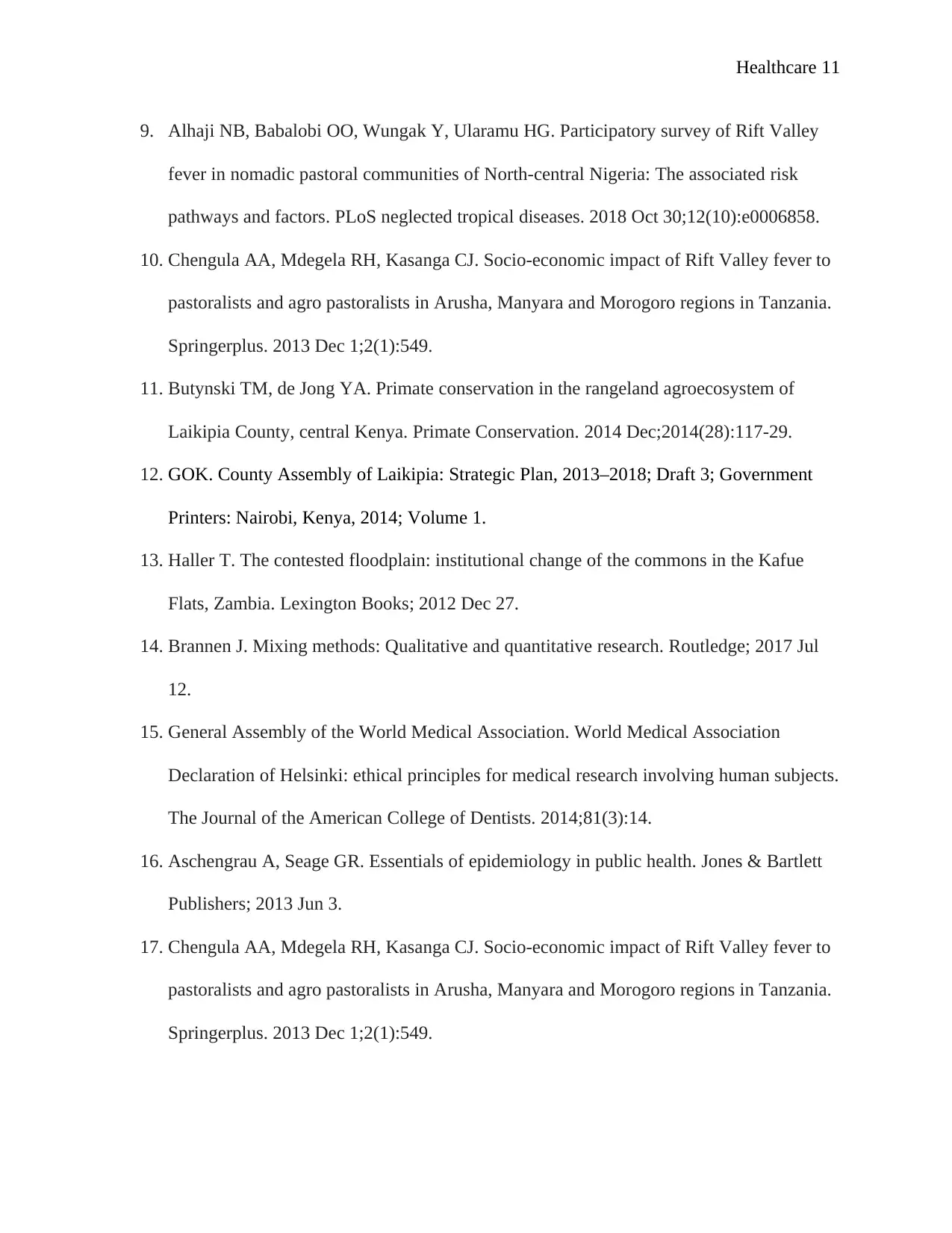
Healthcare 11
9. Alhaji NB, Babalobi OO, Wungak Y, Ularamu HG. Participatory survey of Rift Valley
fever in nomadic pastoral communities of North-central Nigeria: The associated risk
pathways and factors. PLoS neglected tropical diseases. 2018 Oct 30;12(10):e0006858.
10. Chengula AA, Mdegela RH, Kasanga CJ. Socio-economic impact of Rift Valley fever to
pastoralists and agro pastoralists in Arusha, Manyara and Morogoro regions in Tanzania.
Springerplus. 2013 Dec 1;2(1):549.
11. Butynski TM, de Jong YA. Primate conservation in the rangeland agroecosystem of
Laikipia County, central Kenya. Primate Conservation. 2014 Dec;2014(28):117-29.
12. GOK. County Assembly of Laikipia: Strategic Plan, 2013–2018; Draft 3; Government
Printers: Nairobi, Kenya, 2014; Volume 1.
13. Haller T. The contested floodplain: institutional change of the commons in the Kafue
Flats, Zambia. Lexington Books; 2012 Dec 27.
14. Brannen J. Mixing methods: Qualitative and quantitative research. Routledge; 2017 Jul
12.
15. General Assembly of the World Medical Association. World Medical Association
Declaration of Helsinki: ethical principles for medical research involving human subjects.
The Journal of the American College of Dentists. 2014;81(3):14.
16. Aschengrau A, Seage GR. Essentials of epidemiology in public health. Jones & Bartlett
Publishers; 2013 Jun 3.
17. Chengula AA, Mdegela RH, Kasanga CJ. Socio-economic impact of Rift Valley fever to
pastoralists and agro pastoralists in Arusha, Manyara and Morogoro regions in Tanzania.
Springerplus. 2013 Dec 1;2(1):549.
9. Alhaji NB, Babalobi OO, Wungak Y, Ularamu HG. Participatory survey of Rift Valley
fever in nomadic pastoral communities of North-central Nigeria: The associated risk
pathways and factors. PLoS neglected tropical diseases. 2018 Oct 30;12(10):e0006858.
10. Chengula AA, Mdegela RH, Kasanga CJ. Socio-economic impact of Rift Valley fever to
pastoralists and agro pastoralists in Arusha, Manyara and Morogoro regions in Tanzania.
Springerplus. 2013 Dec 1;2(1):549.
11. Butynski TM, de Jong YA. Primate conservation in the rangeland agroecosystem of
Laikipia County, central Kenya. Primate Conservation. 2014 Dec;2014(28):117-29.
12. GOK. County Assembly of Laikipia: Strategic Plan, 2013–2018; Draft 3; Government
Printers: Nairobi, Kenya, 2014; Volume 1.
13. Haller T. The contested floodplain: institutional change of the commons in the Kafue
Flats, Zambia. Lexington Books; 2012 Dec 27.
14. Brannen J. Mixing methods: Qualitative and quantitative research. Routledge; 2017 Jul
12.
15. General Assembly of the World Medical Association. World Medical Association
Declaration of Helsinki: ethical principles for medical research involving human subjects.
The Journal of the American College of Dentists. 2014;81(3):14.
16. Aschengrau A, Seage GR. Essentials of epidemiology in public health. Jones & Bartlett
Publishers; 2013 Jun 3.
17. Chengula AA, Mdegela RH, Kasanga CJ. Socio-economic impact of Rift Valley fever to
pastoralists and agro pastoralists in Arusha, Manyara and Morogoro regions in Tanzania.
Springerplus. 2013 Dec 1;2(1):549.
1 out of 11
Related Documents
Your All-in-One AI-Powered Toolkit for Academic Success.
+13062052269
info@desklib.com
Available 24*7 on WhatsApp / Email
![[object Object]](/_next/static/media/star-bottom.7253800d.svg)
Unlock your academic potential
Copyright © 2020–2025 A2Z Services. All Rights Reserved. Developed and managed by ZUCOL.



